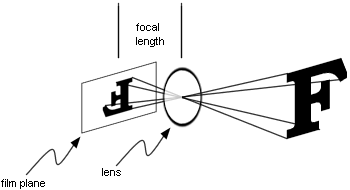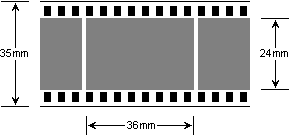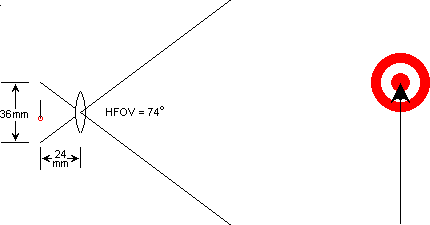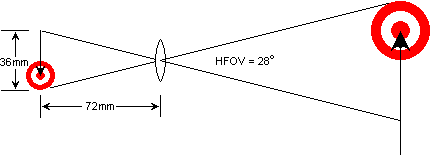|
|||||||||||||||||||||||||
|
What is "35mm equivalent focal length?"
When you look at lens specifications for digital cameras, you'll see all sorts of different things. Some camera makers list the focal length this way:
Others list something like this:
While others just say:
So what's going on here? How can a lens be 8mm and 38mm at the same time? Why are some of the numbers so small? And just what is "35mm equivalence?" This article explains the focal length specifications for digital cameras and explains why you can't really compare focal lengths between different digital cameras. The "focal length" of a lens is the distance between the optical center of the lens and the place where it focuses its image. For conventional cameras, the place where the image is formed is the film plane. For digital cameras, it is the imaging sensor, usually a CCD array. To make it easier think about this, we can pretend that the rays of light pass through the optical center on their way to the film plane or the imaging sensor. In fact, this is exactly how a pinhole camera works.
What does the 35 mean in "35mm camera?" Let's get something out of the way. Lots of things on a camera are measured in millimeters. For 35mm cameras, there are two measurements that are sometimes confused with the focal length. First, the 35 in "35mm camera" doesn't refer to the focal length or even to the size of the image on the film. It is the width of the film including the sprockets. 35mm film is more properly called 135 format film and has these dimensions:
It can be confusing when a 35mm camera is described as having a 35mm lens. Does this mean that the lens has a 35mm focal length (very possible) or that the writer is being specific about the camera, not the lens? Sometimes it's hard to be sure. The second measurement that is sometimes confused with the focal length is the diameter of the filter ring. This is the threaded ring on the front of the lens barrel that accepts Filter rings come in various sizes like 49mm, 52mm, 58mm. This size is dictated by the diameter of the lens barrel and is independent of the lens focal length. What makes a lens wide angle or telephoto? The relationship between the focal length of the lens and the size of the imaging area (film plane or CCD array) determines the field of view of the camera. If the focal length is smaller, the field of view is wider and vice versa. For example, consider a 35mm camera. The image formed on the film by a 35mm camera is 36mm wide and 24mm high. So, for example, if the focal length of the lens is 24mm, the horizontal field of view is 74° -- a wide angle.
If the focal length is tripled to 72mm, the horizontal field of view reduces to 28°. This produces a higher magnification, and it is considered a telephoto lens.
A "normal" lens produces a field of view that is similar to human vision. The diagonal of the image plane is typically used as the reference for field of view determination. A "normal" lens has a focal length that is approximately equal to the diagonal measurement of the image plane. When the focal length is equal to the diagonal measurement it produces a diagonal field of view of approximately 53° which is similar to human vision. For 35mm film (24mm by 36mm), the diagonal measurement is 43.27mm. 50mm is close to this measurement so it is considered a "normal" lens. A 50mm lens produces a 47° diagonal field of view which is close to 53°. The CCD arrays on digital cameras are typically much smaller than the imaging area of 35mm film. This means that the focal length that produces a "normal" field of view is much smaller than 50mm. Unlike 35mm film which is the same regardless of what camera you use, the size of the CCD array varies from camera to camera. This poses a problem. You cannot know whether a focal length is "normal", wide angle or telephoto without knowing the exact size of the CCD array. Unfortunately, even knowing the exact size of the CCD array may not help because sometimes the imaging area doesn't even cover the entire array! Because many people are familiar with focal lengths of lenses for 35mm cameras, the digital camera manufacturers choose to describe the focal length of their cameras by reference to the focal length that would produce a similar field of view on a 35mm camera. Consider, for example, a digital camera with a CCD array measuring 8.10mm by 6.08mm. The diagonal measurement of this CCD array would be 10.13mm. A lens with a focal length of 11.7mm would produce a diagonal field of view of 47°, the same as a 50mm lens on a 35mm camera. So for this camera, an 11.7mm lens would be described as having a 35mm equivalent focal length of 50mm. By describing the lenses this way, the digital camera companies appeal to users' familiarity with 35mm camera equipment. Are all digital cameras the same? Unfortunately the digital camera companies do not all use the same method for determining 35mm equivalency. There are at least three methods used by camera manufacturers. Some camera companies use the diagonal field of view exactly as described in this article. That is, if they describe a camera as having a particular 35mm equivalent focal length, it means the camera produces the same field of view along the diagonal as a 35mm camera with a lens having the stated focal length. Other companies use the horizontal field of view rather than the diagonal field of view. This produces a slightly different result from using the diagonal because the aspect ratio of the digital image (usually 4:3) is different from the aspect ratio of 35mm film images (exactly 3:2). When a digitial camera produces the same horizontal field of view as a 35mm camera with a lens having a particular focal length it actually has a larger diagonal field of view. Finally, some companies describe the camera as having a 35mm equivalent focal length of 50mm if the focal length is exactly equal to the diagonal measurement of the CCD array and scale all other focal lengths accordingly. In this way they appeal directly to the idea that 50mm is the "normal" focal length. These cameras actually have a larger field of view in all directions when compared to a 35mm camera with a lens having the stated focal length. Unfortunately, this means that one camera maker's 50mm equivalent may or may not have the same field of view as another. And you can't compare actual focal lengths without knowing the size of the image on the CCD array. What does this mean to users of The Panorama Factory? To properly align the images, The Panorama Factory must know the camera’s focal length. Because of the variation in how digital camera manufacturers determine 35mm equivalency The Panorama Factory cannot know exactly how to interpret the stated focal length. (For conventional cameras, similar problems arise from variation in the effects produced by scanning and printing methods.) For these reasons, it is a good idea to use focal length refinement the first time you stitch a panorama with a particular camera, lens and imaging setup even if you are confident that you know the focal length specification. You should remember the focal length value computed by The Panorama Factory and use it as the initial value for subsequent panoramas. Until we can know the exact rule used by each digital camera for determining 35mm equivalency, the rated focal length of a digital camera can only be a starting point for refinement. The variation in methods used by different manufacturers introduces a greater level of uncertainty in the focal length value, perhaps as much as plus-or-minus 15%. You should consider this uncertainty when setting the limits for focal length refinement. |
||||||||||||||||||||||||
|
Revised: April 28, 2004 © 1999-2005 Smoky City Design, LLC and John Strait |
|||||||||||||||||||||||||



